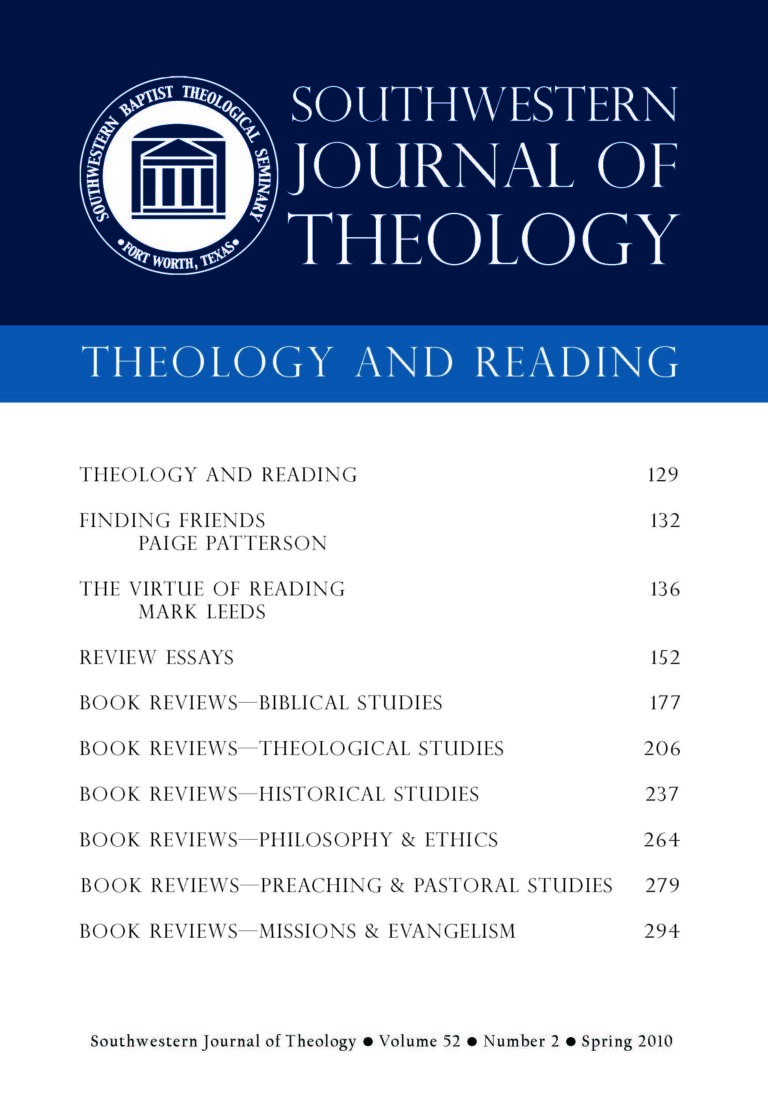
Theology and Reading
Southwestern Journal of Theology
Volume 52, No. 2 – Spring 2010
Managing Editor: Malcolm B. Yarnell III
By Bryan E. Beyer. Grand Rapids: Baker Academic, 2007. 304 pages. Hardcover, $26.99.
Bryan E. Beyer’s Encountering the Book of Isaiah: A Historical and Theological Survey represents a recent addition to Baker Academic’s Encountering Biblical Studies series. Beyer, who teaches Old Testament at Columbia International University Seminary and School of Missions, has contributed two other volumes in the same series, Encountering the Old Testament: A Christian Survey, which he co-authored with Bill T. Arnold, and Readings from the Ancient Near East: Primary Sources for Old Testament Study, which he co-edited with Arnold. Beyer is also the Old Testament Book Review Editor for the Journal of the Evangelical Theological Society.
Beyer intends for his book to serve as a primer on Isaiah for advanced students in biblical studies (17). He initiates this task by providing a biographical discussion of Isaiah, which includes a description of his role as a prophet and the setting in which he conducted his ministry, and devotes the majority of his work to surveying the content of the book of Isaiah. Within his survey, Beyer introduces his readers to historical, critical (such as the issue of Isaianic authorship and date), and theological matters relevant for understanding the book’s message. He concludes his book with chapters devoted to Isaiah’s relationship to the Old and New Testaments, and the relevance of Isaiah’s message to the Great Commission.
A praiseworthy feature of the book is its user-friendly format. Each chapter begins with an outline of its content, which usually amounts to an outline of the portion of Isaiah’s text that the particular chapter covers, as well as study objectives for Beyer’s readers. Throughout the book are several sidebars which summarize information closely related to the discussion at hand, and which give students a base from which to launch further exegetical study. Each chapter concludes with study questions which help Beyer’s readers review the highlights of the most recent subject matter.
The content of Encountering the Book of Isaiah is commendable in a number of places. Beyer’s discussion of the major interpretations of the Immanuel prophecy in Isaiah 7 is succinct, yet not too brief to be unhelpful. He not only outlines the interpretations themselves, but explains with clarity the different exegetical decisions driving the interpretations, encouraging readers to come to their own conclusions on the matter. Beyer’s treatment of the connection between the oracles against the nations in Isaiah 13–23 and what precedes in chapters 1–12 is cogent. Here, he argues that the nations represent opposition to God’s redemptive plan which he has begun to work out through Israel. In his chapter on Isaiah’s relationship to the rest of the Old Testament, Beyer suggests that many Isaianic themes (holiness, sacrifice, etc.) reflect Isaiah’s theological dependence on the Torah. Within the same chapter, Beyer introduces his readers to a variety of passages within the Psalms and prophets that make use of theological emphases (such as the Holy One of Israel) also found within Isaiah.
Beyer’s chapter on the relationship between Isaiah and the Great Commission helps readers see Isaiah’s relevance for the church’s present missiological task. However, Beyer’s sharp distinction between the material, temporal nature of the creation mandate (Gen 1:26–28) and the spiritual, eternal nature of the Great Commission (Matt 28:18–20) perhaps unnecessarily dichotomizes these two biblical focuses (264–66). Isaiah’s teachings about the nations should shape how the church views the weight of the Great Commission, but Isaiah himself seems to embrace an eschatological vision of a redeemed physical earth, rather than merely clinging to immaterial, spiritual hopes (Isa 11:6–9).
Another criticism of Beyer’s thoughtful work should perhaps be mentioned. His interaction with Isaiah scholarship is at times less than what one would expect, even for an introductory volume. Beyer desires for his book to be a work introducing advanced Bible students to Isaiah; however, a book which has this audience in mind should direct its readers to additional works by both critical and conservative scholars so as to give them direction for further study. Beyer’s discussion of the authorship of Isaiah 40–66 would have been even stronger if he would have directly interacted with significant figures (Duhm; Blenkinsopp) in the opposing camp (153–161). Similarly, interaction with significant commentators would enrich his already beneficial discussion of the various interpretations of the Immanuel prophecy of Isaiah 7.
Beyer’s volume, nonetheless, would be quite useful for studying the book of Isaiah in a number of contexts. Beyer tackles the exegetical issues of Isaiah while maintaining an interest in the relevance of the book for the lives of Christians. I recommend the book not only to professors and seminary students, but to pastors and experienced teachers in the local church who wish to lead congregations through a study of this important prophet.





